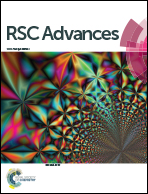Overproduction of lipopeptide biosurfactant by Aneurinibacillus thermoaerophilus HAK01 in various fed-batch modes under thermophilic conditions†
Abstract
An efficient lipopeptide biosurfactant (BS) producer, Aneurinibacillus thermoaerophilus HAK01, was isolated from municipal landfill sites. The strain was able to produce about 4.9 g L−1 lipopeptide at a thermophilic temperature of 45 °C. After optimization of culture component concentrations using the response surface method, the main focus is to find the most appropriate fed-batch strategy to enhance lipopeptide production by the HAK01 strain. For this purpose, four fed-batch strategies including (a) pH-stat mode, (b) constant feeding rate strategy, (c) DO-stat mode, and (d) combined feeding strategy were designed. The production of BS was increased systematically from 4.9 g L−1 in batch mode to 5.9, 7.1, 8.8 and 11.2 g L−1 in each fed-batch mode, respectively. While poor results were obtained in the pH-stat mode, the DO-stat mode showed excellent results in the production of BS. The results of the study confirmed the importance of operational mode, oxygen supply and the kind of feeding strategy in BS production.



 Please wait while we load your content...
Please wait while we load your content...